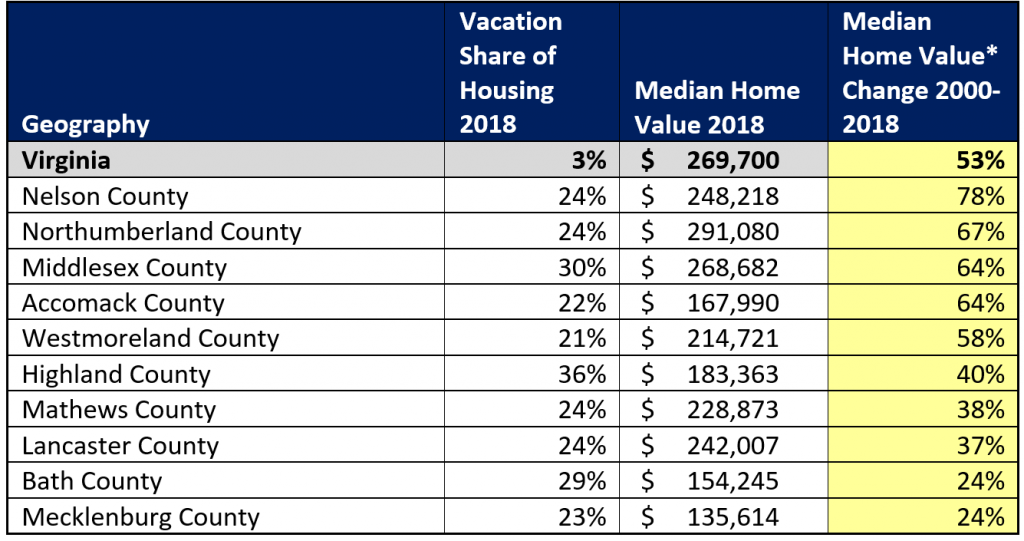Where are the vacation homes in Virginia?
Lower mortgage rates and a rise in concentrated wealth nationwide has resulted in more people buying second homes. With a multitude of natural, historical, and cultural amenities, Virginia is an attractive location to spend leisure time and a prime location to purchase a vacation home. Within the Commonwealth, the percentage of homes in an area that are vacation units, or the vacation share of housing, varies by the region. However, prices in areas with a high percentage of vacation homes are increasing faster than the median price of homes in Virginia and the U.S. overall. A high or increasing vacation share of housing can indicate the area is an attractive destination, which can boost the local economy, but it also may bring unintended consequences, such as an increase in overall housing costs.

|
Vacation Counties
In 2018, there were just over 88,000 vacation homes in Virginia – about 2.5 percent of all homes in the Commonwealth. Counties that have a share of vacation homes higher than the state as a whole are shown in figure 1 below. Areas with a share of vacation homes higher than 20 percent are considered “vacation home counties” per a definition by the National Association of Realtors and are designated in dark blue. Vacation home counties comprise 10.5 percent of all jurisdictions in Virginia, compared to 6.6 percent in the U.S. as a whole.

Source: U.S. Census Bureau American Community Survey
Amenity-rich, rural counties are more likely to have vacation homes. Nationwide, nearly 60 percent of all vacant seasonal or recreational homes are located in rural counties*. In Virginia, this statistic is around 51 percent with a high share of vacation homes located along the eastern shore, along the Blue Ridge and Valley, and in Southside along the North Carolina border. Vacation share of housing is growing across the state, especially in certain rural areas as seen in Figure 2.

Source: U.S. Census Bureau American Community Survey
Virginia Vacation County Prices
Virginia vacation counties are not nearly as expensive as many counties in other states with a median price of around $220,000, but some vacation counties are costlier than others. For example, the median housing price is around $300,000 in Northumberland County – the only vacation county with a higher median home value than the state as a whole. However, most locations in Virginia offer a bargain for vacation home buyers. In Mecklenburg and Bath Counties median home prices are around $135,000 and $154,000, respectively.

Source: U.S. Census Bureau American Community Survey *Home value adjusted for inflation
Home values in Virginia vacation counties may not be exceptionally expensive right now, but this may not continue to be the case. Prices in vacation home counties are rising faster overall than the rest of the market. Between 2000 and 2018, the average median home price rose 50 percent in Virginia counties with vacation shares above 20 percent, compared to 39 percent in counties with lower vacation home shares. Other than Northern Virginia, some areas where the price of homes has risen the most since 2000 are high vacation counties, such as Nelson County and the Eastern Shore.
Wealthy residents and retirees living in Northern Virginia, Richmond, Hampton Roads, and even Raleigh who increasingly desire a weekend or seasonal home may be attracted to the affordability and solitude of rural Virginia. As a result, demand and prices can be expected to continue to rise, creating affordability problems.
Outlook
The demand and the prices for vacation homes has risen in recent years and part of rural Virginia are well poised to become destination areas, which is not necessarily a bad thing. The high and rising share of vacation homes in areas of Virginia that are experiencing outmigration, aging, and low incomes may provide an economic boost, but it is important to take into account the unintended consequences of rising home prices. As destination areas become more popular, consumption, expenditure, and local tax revenue may get a boost. This creates more jobs, yet it may cause housing prices to escalate, making it difficult for local workers to find a place to live. Will vacation housing drive economic development in Virginia? Will additional vacation units raise affordability issues in those localities? Local government officials will need to address these questions moving forward.
_______________
*Counties outside of Metropolitan Statistical areas. http://www.ruralhome.org/storage/research_notes/rrn-housing-vacancy-web.pdf


